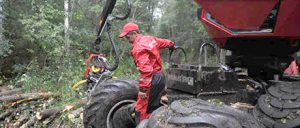The forestry industry must take steps to improve its safety record and promote decent rural employment in support of the Sustainable Development Agenda, according to a new Food and Agriculture Organisation (UN) paper published on World Day for Safety and Health at Work. Source: Timberbiz
The report, Occupational safety and health in forest harvesting and silviculture: A compendium for practitioners and instructors, argues that despite incomplete statistics, forestry is one of the most dangerous civilian professions in the world.
Official accident data show a high toll of injuries and deaths each year in the professional forestry sector, largely reported from developed countries. However, this does not provide a full picture of accidents in the informal forestry sector, thought to employ some 45-50 million people around the world.
“Accidents and fatalities that occur in the informal forestry sector or as a result of illegal logging may not be recorded as forestry accidents, if they are reported at all,” said FAO Forestry Officer Jonas Cedergren, who co-authored the paper. “But it is important to remember that these accidents are no less tragic.
“Reducing all injuries and fatalities is an important part of working towards achieving the Sustainable Development Goals on decent employment, good health and well-being, poverty and equality,” Cedergren said.
Employment in forestry is usually characterized by harsh working conditions, which include felling large, possibly rotten trees, using dangerous tools and bearing heavy physical loads, often in extreme weather.
Vibration from hand-held tools and repetitive tasks can result in musculoskeletal injuries, while noise from chainsaws and brush cutters can lead to a loss of hearing and reduce workers’ awareness of threats from machinery, trees and even wildlife, the FAO paper notes.
Foresters are also often working in challenging terrain, where soils and logs can become slippery when wet, and usually in remote locations far from help.
Poor training, limited supervision, the use of low-tech machines or manual labour, and materials ill-equipped to cope with the safety challenges posed by difficult working conditions can compound the risks in developing countries, according to the report.
Forest workers are also vulnerable to biological hazards such as infections and diseases transmitted by insects and animal bites.
However, the FAO paper finds that there is much that can be done within these constraints to establish a safety culture that minimises risks to worker safety and health.
The report sets out a series of steps to reduce forestry accidents, which include identifying hazards, carrying out safety inspections, ensuring safe work procedures, and providing education and first-aid training.
The report also stresses the need for incident investigation, so that the causes of an accident can be addressed, and for reporting for records and statistics to help identify and resolve recurring problems.
Aimed at producer organisations, trade unions, vocational training institutes, instructors and relevant public bodies, the paper also sets out practical guidance for dealing with safety issues such as biological hazards, chemicals, heat stress and the use of machinery as well as hazards across logging, saw milling, tree planting and harvesting non-wood forest products.
“Forestry is sometimes called a ‘3D’ job – dirty, difficult and dangerous,” Cedergren said. “The industry must improve its safety record and reputation, both to improve decent employment and to attract future generations to the sector.”
The report can be found at http://www.fao.org/documents/card/en/c/ca8773en








